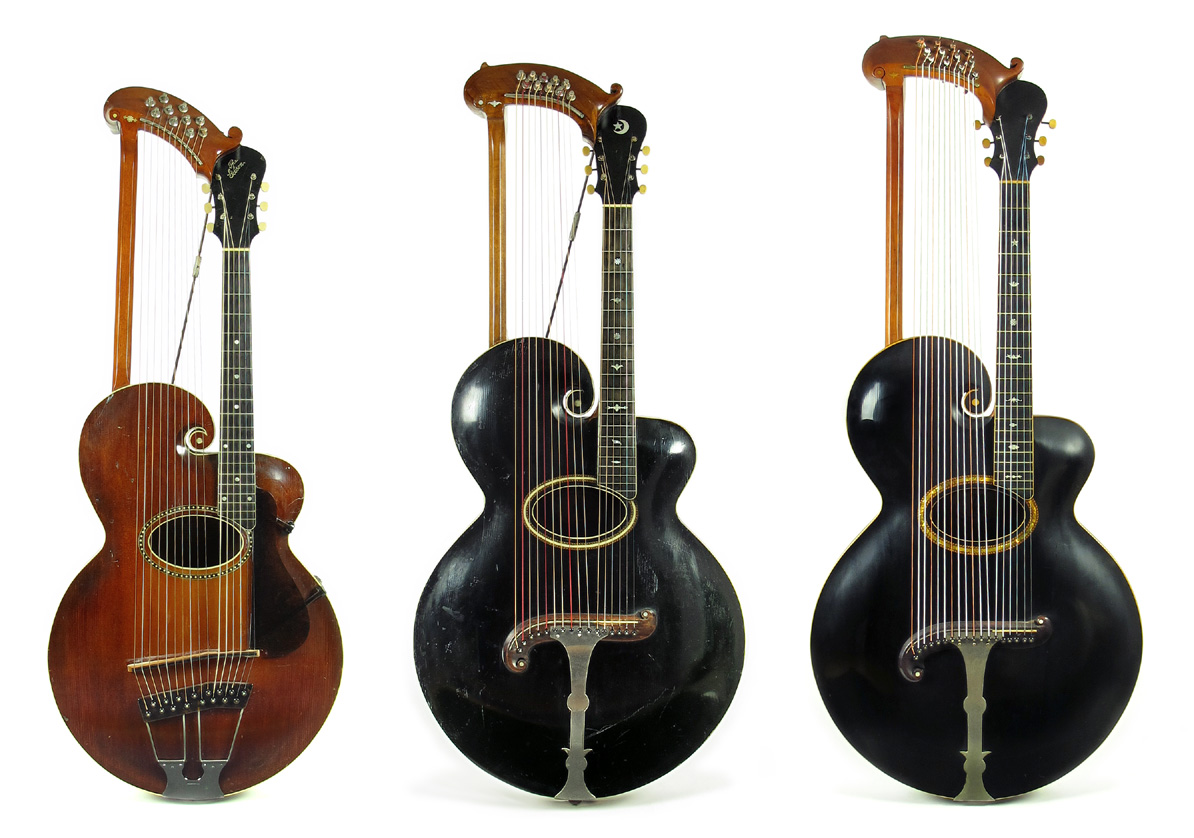
Yes, I looked it up and they’re real words. And just the words to describe Gibson’s harp guitars as we travel backwards in time through their first years of production.
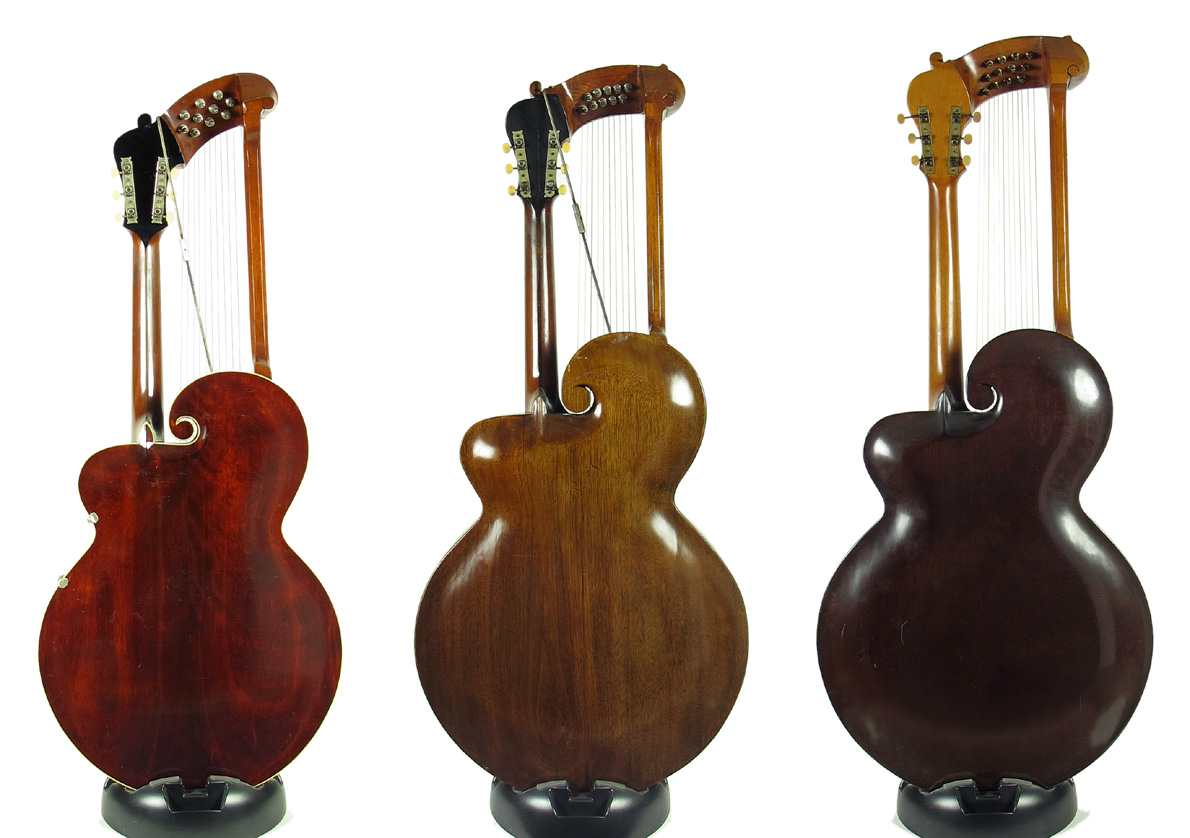
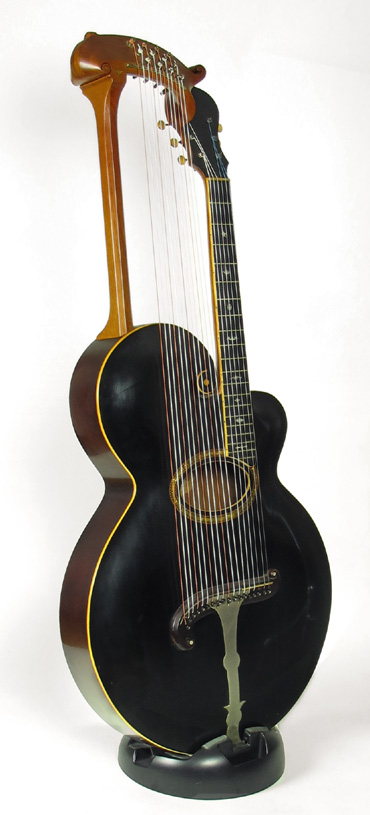
I finally managed to score a long-time goal: a fine example of the 12-bass, long- scale Gibson! According to the spreadsheet Benoit (Meulle-Stef) and I maintain (with an additional thanks to collector Steve Sjuggerud), there are just eight or nine of these currently known to survive, and condition and originality vary dramatically. I had the great opportunity to sell one of them in my first year running Harp Guitar Music – though I never got to see it in person. So here’s my chance, and I thought it would be fun and beneficial to compare the three different models/sizes – photographing them under the exact same setup for scale (above) – while I have them all together (my original scroll bridge U is now for sale). There’s a fourth model that I’ve never owned, the original 6-bass model, which has a body slightly smaller than the common Style U. Maybe someday…
We have all these models and more in the Harpguitars.net Gibson section, but seeing them side by side in front of one is much more revealing. For example, the middle instrument in my first two photos − the last of the 21” bodies with the fixed scroll bridge − always looks the most humungous in any photo. Why? Simple perspective. It has the exact same body as the earlier instrument on the right, but has the shorter 25-5/8″” scale length (usually stated as 25.5, Benoit thinks it’s 65cm). Thus, the body appears more gargantuan in relation to the neck and heads than the “larger” instrument, which is better proportioned with its 27-1/4” scale.
I turned my Photoshop layer experiment into this revolving gif to demonstrate.
Note (while that image is so cleverly switching back and forth) that the bridge location had to be slightly adjusted for the scale, causing the later standard scale model to look even more bulbous under the bridge. Somehow, both necks manage to meet the body between the 12th and 13th frets, with about half a fret difference between them. Interestingly, the bridges are exactly the same width – the outermost sub-bass being in roughly the same position on each, thus opening up the spacing a bit for the 10-bass model (on the right below).
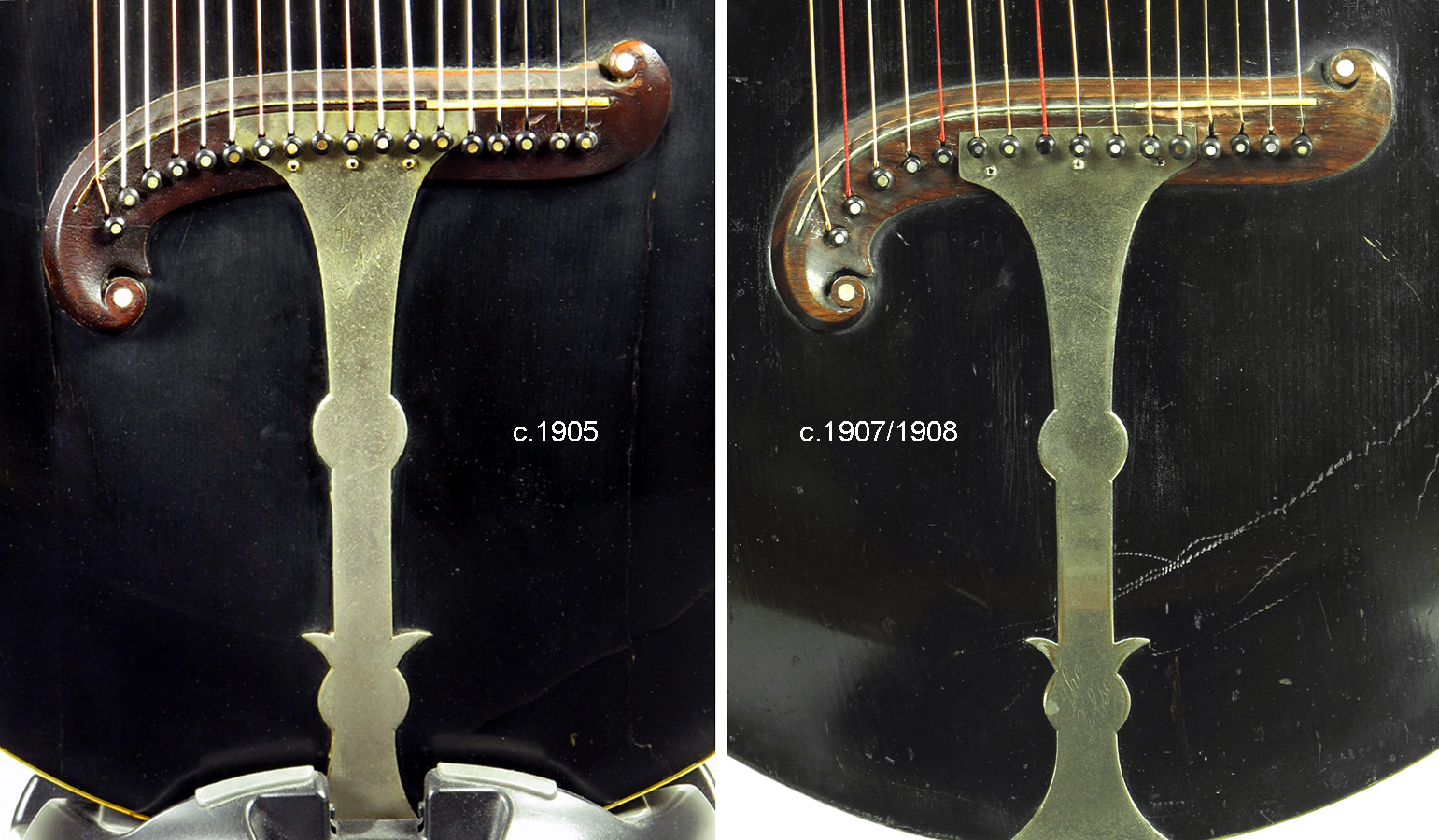
The sound holes are virtually the same size (the very first U’s had a giant sound hole), but the c.1905 has a nice wide swath of green abalone compared to the next iteration of simple ivoroid between similar herringbone rings. PS: Note above and below that I’ve strung these in a color-coded system as Gibson themselves did; every third sub-bass is red (copper or special wrap).
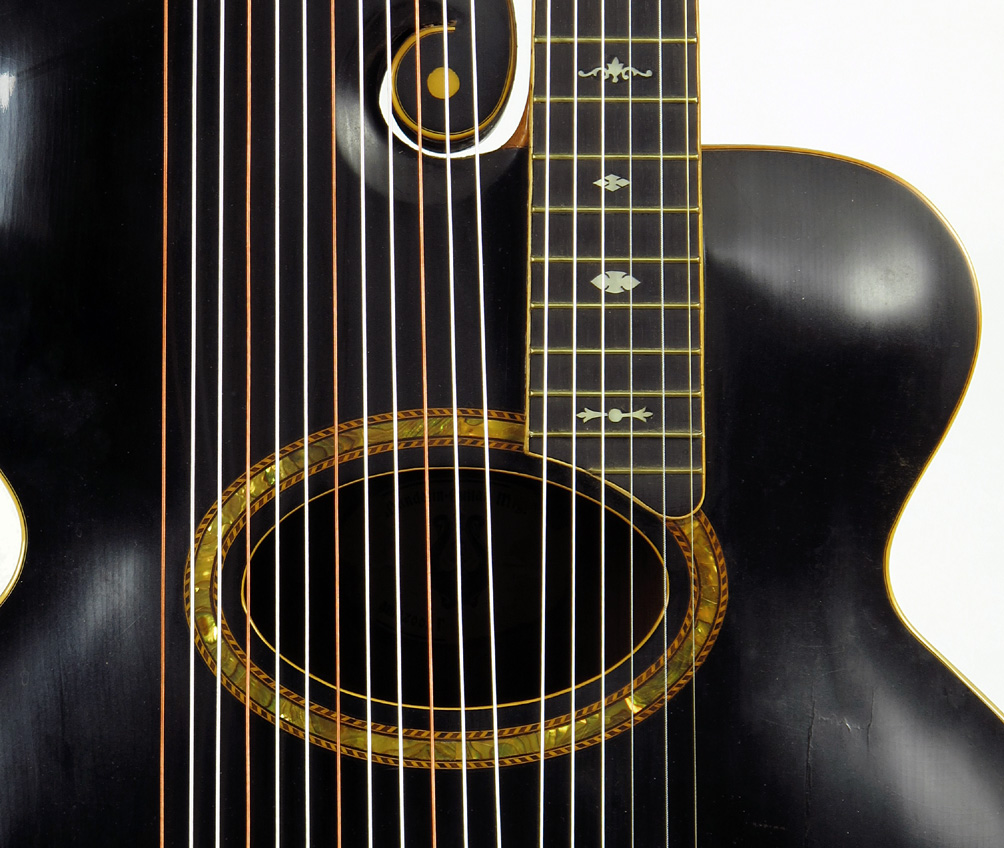

Is the longer-scale Gibson a baritone harp guitar? Almost! But no, that was never the intention. It was for increased string tension. Using typical gauge guitar strings and tuning to standard pitch at the longer scale meant more tension. And tension was what Gibsons were all about. I was astounded when I learned that their practice for either gut or steel strings was to move each one over a string to create enough pressure to drive the incredibly thick carved tops (see this 1914 Sounding Board article). The B string would be on the high E and so on, with a cello string for the low E. And this was all the way through the ‘twenties on the trapeze tailpiece model. Imagine having a wound 2nd string!
I have a colleague who’s been working on stringing his ‘teens Gibson in heavy gut and classical strings in this way, and the results are quite intriguing. I had hoped to try that on my new instrument, but fear even slight tension would only make the repaired and cleated top cracks move more than they already have since being repaired by Gibson in 1966. At that time the factory also re-fretted and completely re-finished it. For now, I’m leaving it in this “not-fully-original, but in a way, authentic” condition.
Now I’ll continue the comparisons, but I’ll add in the Style R, which was contemporaneous with the long-scale U but only had six sub-basses (this specimen, from Gruhn Guitars, has seven original subs).

Left to right are the R and the three key Style U’s (those 3 shown newest model to oldest):
− c.1906 Style R, the smallest Gibson at 17-7/8” wide, 25.5” scale, 7 sub-basses. Though only a bit narrower than the common Style U next to it, it has the most exaggerated shape, standing out nicely in this lineup.
− c.1916 common moveable bridge/trapeze tailpiece model, 18.25” wide, 24.75” scale (shorter than all the others), 10 sub-basses (serial #29740, FON illegible)
− c.1907-1908 fixed scroll bridge model, 21” wide, 25.6” scale, 10 sub-basses (serial # illegible, FON not seen)
− c.1905 fixed scroll bridge model, 21” wide, with 27.25” scale, 12 sub-basses (serial #4142 per Gibson, FON near-invisible)
Additional measurements of my three:
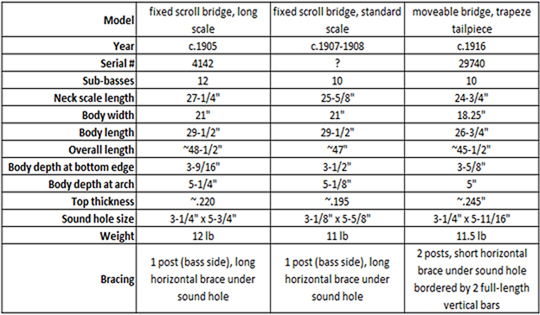
I’ll finish up with some final comparisons between the fixed bridge models.
Both have one-piece backs; the earlier one is mahogany, the later is (we think) walnut (see above photo). The early model lacks the tension rod, added around this time (common c.1906).
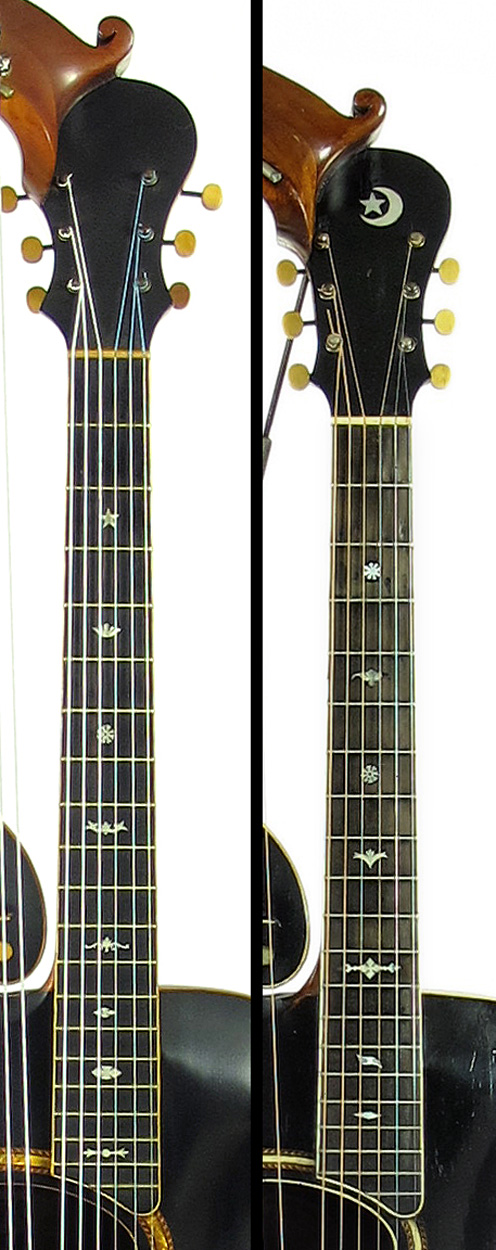
Both have the fancy fingerboard pearl inlays of this constantly-evolving period, though each set seems to have been randomly chosen from the inlay drawer.

The metal tailpiece stays are identical but with “The Gibson” engraving in different locations.
Catalog comparison:
Always of interest to collectors and researchers are locating catalogs that these instruments originally appeared in. In the case of early Gibsons, it’s typically more of a “snipe hunt.” They virtually never match up!
Here are all the catalog scroll-bridge Style U’s we know of:
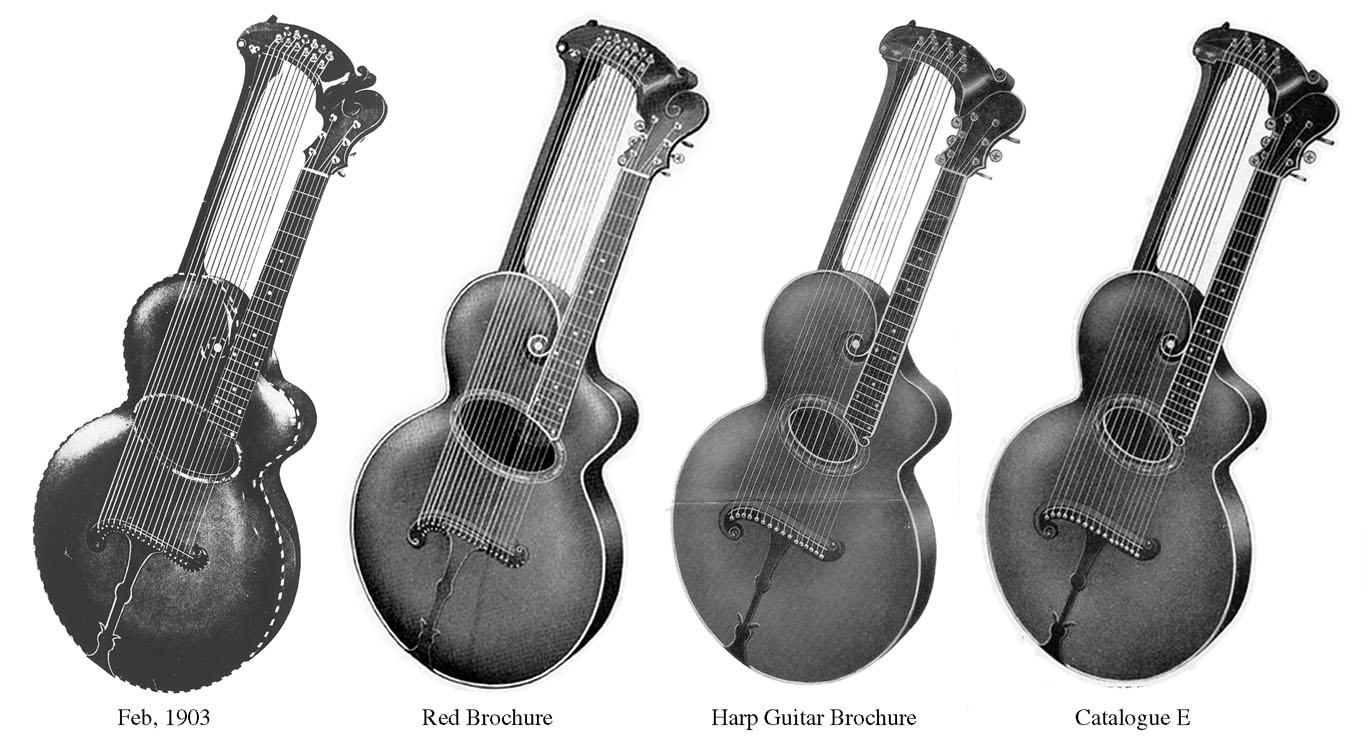
The first 1903 model was made, here’s an image. The others have never been seen quite like those depicted. I discuss this fully in our Gibson Appendix.
Every other surviving 12-bass harp guitar from this period – in both historical photos and extant specimens – has its bass tuners arranged in a 3×4 pattern, never the 2×6 arrangement. They also have the smaller sound hole, not seen in catalogs. Of course, the catalogs are also missing the 9 sub-bass version which Ben and I have now seen so often in historical photos that we can’t believe it was merely a “custom order.” Going by the catalog letters – the first of which are our own assigned guessimates, since Gibson didn’t assign letters until “E” – we still seem to be missing a key early catalog (either 1 or 2). If such a “missing link” exists, I would kill to find it!
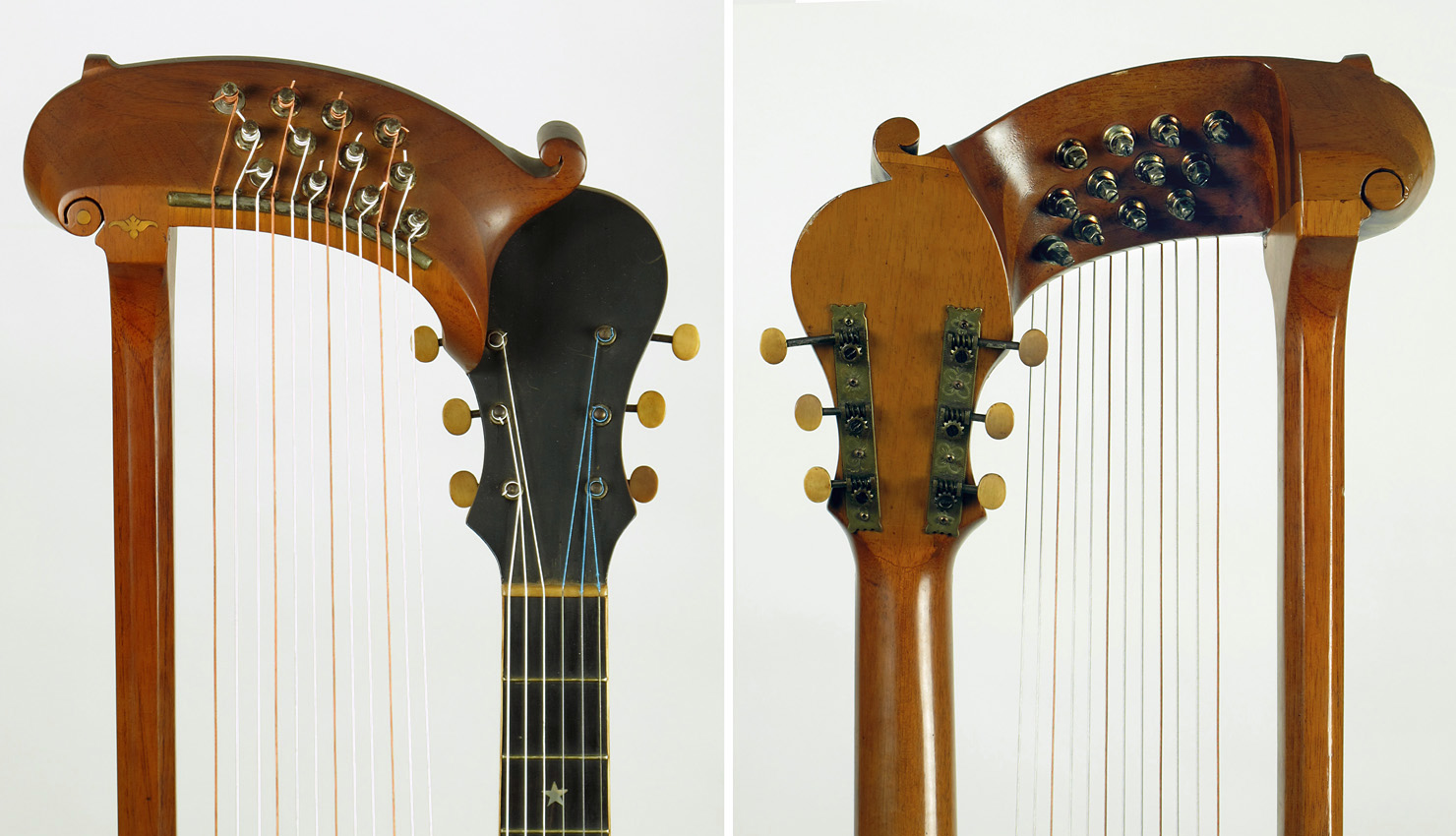
As the headplate of mine was refinished, I don’t know if it originally might have had a “Gibson” logo or crescent and star. I suspect it was bare as many of these early instruments were, as I can’t imagine Gibson altering the customer’s instrument in such an obvious way.
From their very beginnings, harp guitars, especially in the States, have always been giants of the guitar world. The experimental Lyon and Healy Monster Bass Harp Guitar may have been wider by over an inch, Bohmann’s Contrabass Harp Guitar body almost as large – but in America, the original Gibson Style U was and remains the King of Harp Guitars!

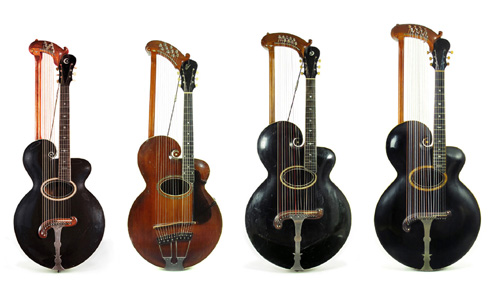
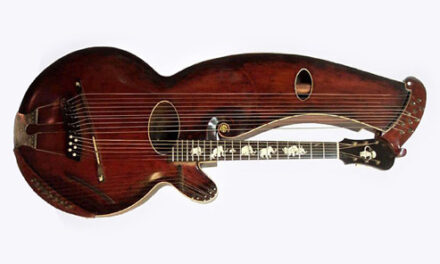
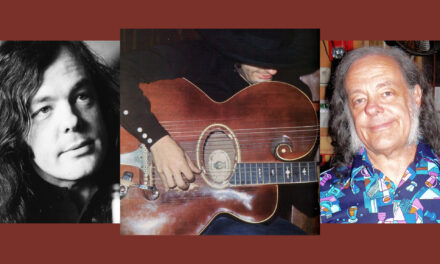
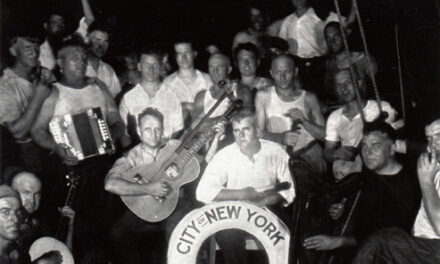
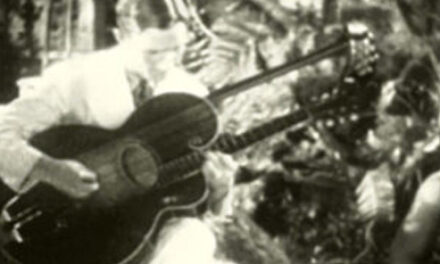
I have a Gibson “R” and it sounds pretty good to me, especially the basses. I did have to sand it for refinishing and add many, many internal cleats to stabilize the top. It may have originally sounded even better if that work had not been necessary. My 3 Sullivan/Elliott HGs with the Bellinger bracing and phosphor bronze basses sound better but they are not over 100 years old either. I really love to play my harp guitars! My Gibson Style 0 (scroll 6 string) is half done. When completed, It will sit next to my “R” in my mini museum (living room).
Michael
Can’t be more agreed with you Gregg, by far the early glued bridge models are better sounding
It is interesting to note that it was George Laurian who did the re-design of the Style U around 1908 and established the now standard Gibson scale length of 24 3/4″. He was able to improve many features of the HG by making the top, sides and back thinner with better bracing, thus making it possible to use a shorter scale length and lower tension.
Indeed, Paul. And yet, the 1916 has the thickest top by far (with, as you say, additional bracing), and they were still advocating the “move the strings over one” for super heavy tension…(?!)
A beauty. This was a good read.